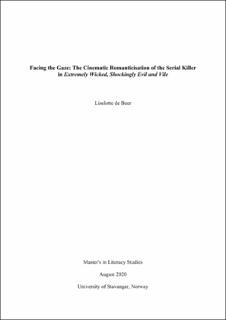Facing the Gaze: The Cinematic Romanticisation of the Serial Killer in Extremely Wicked, Shockingly Evil and Vile
Master thesis

View/
Date
2020-08-31Metadata
Show full item recordCollections
- Student papers (HF-IKS) [770]
Abstract
A dominant trend in theories on serial killer cinema has been the notion of the serial killer celebrity. However, it may be argued that cinema in fact goes further than merely creating celebrity killers. More disturbingly cinema has created a platform in which a normalised and romanticised figure is constructed whom the spectator can form an allegiance with and even have empathy towards. The film Extremely Wicked, Shockingly Evil and Vile (2019) deals with the serial killer Ted Bundy and can be described as somewhat unique in the serial killer film genre because it presents itself not as a serial killer film, but as a romantic drama with the protagonist poised as a romantic hero. The shift from a serial killer film towards a romance film is precisely why this film necessitates further investigation.
This thesis argues that Extremely Wicked, Shockingly Evil and Vile creates a romanticised serial killer through the use of the cinematic gaze and the engagement with the face and the close-up. The gaze is used to interpellate the spectator into the filmic universe and creates a fantasmatic scenario in which the serial killer is not seen as a brutal killer but as a romantic hero. Added to this, the face and the close-up are employed to construct an empathetic character out of the serial killer. Examining the way in which Extremely Wicked, Shockingly Evil and Vile uses its employment of the gaze and engagement with the face may serve to illuminate how the film romanticises the notorious figure of Ted Bundy. This may then in turn expose the problematic relationship between the cinematic medium’s portrayal of serial killers as well as the responsibility that cinema has in its representation of these killers.
Description
Master's thesis in Literacy Studies